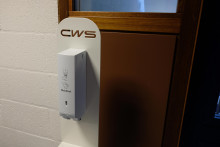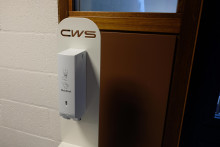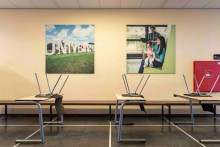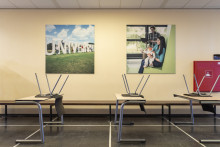The university asks that its staff and students focus on personal responsibility, says real estate portfolio manager Nico-Tom Pen, who is a member of the UT's ‘1.5 metre team’. ‘How successful these measures are depends on how people deal with them. That's why our motto is: take care of yourself and those around you.’
Forty percent
‘Those in management positions will play a crucial role,’ says Pen. 'They will have to carefully consider the work schedules, to prevent campus occupancy from exceeding forty percent.’ Chantal Hilgeholt, manager facility services, adds: ‘If an employee says they want to work on location on Monday and Thursday, that doesn't mean they can just head to campus on Tuesday morning as well.’
Some corona measures on campus are clearly visible. Disinfectant stations have been installed at all entrances and banners remind visitors of the corona regulations. Cleaning is getting additional attention too, says Hilgeholt. ‘For example, cleaning contact points like door handles. Or the additional cleaning for the toilet facilities near the occupied lecture rooms during evening courses.’
In the UT buildings, that fully reopen this week, walking routes will ensure a safe ‘traffic flow’ of staff and students. ‘However, we are putting up as few signs as possible,’ says Hilgeholt. ‘If you put arrows everywhere, eventually people will stop noticing them altogether. This is why only certain problem areas will have signs. For all other areas inside the buildings the rule is simply: look to the right, keep to the right.’
Ventilation
Then there is the matter of ventilation. How does the UT ensure clean air indoors? ‘For starters, we want to make sure there are never too many people in any given space,’ says Pen. ‘Additionally, our technicians have carefully inspected the ventilation of each and every building. They made adjustments to ensure plenty of fresh air can get in. These measures, coupled with the lowered capacity, means the ventilation at the UT is satisfactory. Some buildings do not have mechanical ventilation and are dependent on natural ventilation – in other words: opening windows and vents. These buildings, like Cubicus, are getting some extra attention. The general motto is: if there is more than one person in any given room, please open the windows.’
Within the buildings themselves, the so-called ‘corona coordinators’ will see to it that people adhere to the measures, says Hilgeholt. ‘They are appointed from within their own department or faculty. They will not be ‘unfamiliar’ faces. The coordinators will be monitoring the situation. If, for example, five people are occupying a room meant for three people, they will talk to them about it. More than anything, we are hoping that staff and students will hold each other accountable. Inform people about the 1.5 metres of social distancing.’
According to Pen, everyone involved in making the UT campus ‘corona proof’ in the last few months has been operating in ‘uncharted territory’. ‘We have been very conscientious in developing a plan for the UT, all in line with the guidelines provided by the RIVM (the National Institute for Public Health and the Environment). For new students and employees in particular, in-person meetings are absolutely vital. That is exactly why we're facilitating physical meetings, keeping in mind the 40 percent occupancy as a safe standard. At the same time, we should note that working from home will continue to be the norm. We are confidently “reopening” the UT. Nevertheless, we will continue to keep a close eye on the situation.’







